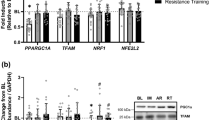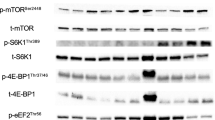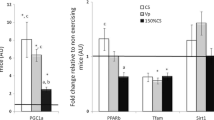Abstract
Purpose
To examine the relationship between changes in nuclear factor erythroid 2-related factor 2 (Nrf2) expression and markers of mitochondrial biogenesis in acutely and chronically exercised human skeletal muscle.
Methods
The impact of acute submaximal endurance (END) and supramaximal interval (Tabata) cycling on the upregulation of Nrf2 (and its downstream targets), nuclear respiratory factor-1 (NRF-1) and mitochondrial transcription factor A (TFAM) mRNA expression was examined in healthy young males (n = 10). The relationship between changes in citrate synthase (CS) maximal activity and the protein content of Nrf2, heme oxygenase 1 (HO-1), NRF-1, and TFAM was also investigated following 4 weeks of Tabata in a separate group of males (n = 21).
Results
Nrf2, NRF-1, and HO-1 mRNA expression increased after acute exercise (p < 0.05), whereas the increase in superoxide dismutase 2 (SOD2) mRNA expression approached significance (p = 0.08). Four weeks of Tabata increased CS activity and Nrf2, NRF-1, and TFAM protein content (p < 0.05), but decreased HO-1 protein content (p < 0.05). Training-induced changes in Nrf2 protein were strongly correlated with NRF-1 (r = 0.63, p < 0.01). When comparing protein content changes between individuals with the largest (HI: + 23%) and smallest (LO: − 1%) observed changes in CS activity (n = 8 each), increases in Nrf2 and TFAM protein content were apparent in the HI group only (p < 0.02) with medium-to-large effect sizes for between-group differences in changes in Nrf2 (ηp2=0.15) and TFAM (ηp2 = 0.12) protein content.
Conclusion
Altogether, our findings support a potential role for Nrf2 in exercise-induced mitochondrial biogenesis in human skeletal muscle.





Similar content being viewed by others
References
Adhihetty PJ, Uguccioni G, Leick L et al (2009) The role of PGC-1α on mitochondrial function and apoptotic susceptibility in muscle. Am J Physiol Cell Physiol 297:C217–C225. https://doi.org/10.1152/ajpcell.00070.2009
Ballmann C, McGinnis G, Peters B et al (2014) Exercise-induced oxidative stress and hypoxic exercise recovery. Eur J Appl Physiol 114:725–733. https://doi.org/10.1007/s00421-013-2806-5
Ballmann C, Tang Y, Bush Z, Rowe GC (2016) Adult expression of PGC-1α and -1β in skeletal muscle is not required for endurance exercise-induced enhancement of exercise capacity. Am J Physiol-Endocrinol Metab 311:E928–E938. https://doi.org/10.1152/ajpendo.00209.2016
Bergstrom J (1975) Percutaneous needle biopsy of skeletal muscle in physiological and clinical research. Scand J Clin Lab Invest 35:609–616
Christensen PM, Gunnarsson TP, Thomassen M et al (2015) Unchanged content of oxidative enzymes in fast-twitch muscle fibers and VO2 kinetics after intensified training in trained cyclists. Physiol Rep. https://doi.org/10.14814/phy2.12428
Crilly MJ, Tryon LD, Erlich AT, Hood DA (2016) The role of Nrf2 in skeletal muscle contractile and mitochondrial function. J Appl Physiol 121:730–740. https://doi.org/10.1152/japplphysiol.00042.2016
Done AJ, Newell MJ, Traustadóttir T (2017) Effect of exercise intensity on Nrf2 signalling in young men. Free Radic Res 51:646–655. https://doi.org/10.1080/10715762.2017.1353689
Edgett BA, Foster WS, Hankinson PB et al (2013) Dissociation of increases in PGC-1α and its regulators from exercise intensity and muscle activation following acute exercise. PLoS ONE 8:e71623. https://doi.org/10.1371/journal.pone.0071623
Edgett BA, Bonafiglia JT, Baechler BL et al (2016) The effect of acute and chronic sprint-interval training on LRP130, SIRT3, and PGC-1 α expression in human skeletal muscle. Physiol Rep 4:e12879. https://doi.org/10.14814/phy2.12879
Fan W, He N, Lin CS et al (2018) ERRγ promotes angiogenesis, mitochondrial biogenesis, and oxidative remodeling in PGC1α/β-deficient muscle. Cell Rep 22:2521–2529. https://doi.org/10.1016/j.celrep.2018.02.047
Fernandez-Marcos PJ, Auwerx J (2011) Regulation of PGC-1α, a nodal regulator of mitochondrial biogenesis. Am J Clin Nutr 93:884S–890S. https://doi.org/10.3945/ajcn.110.001917
Freyssenet D, Berthon P, Denis C (1996) Mitochondrial biogenesis in skeletal muscle in response to endurance exercises. Arch Physiol Biochem 104:129–141. https://doi.org/10.1076/apab.104.2.129.12878
Granata C, Jamnick NA, Bishop DJ (2018) Principles of exercise prescription, and how they influence exercise-induced changes of transcription factors and other regulators of mitochondrial biogenesis. Sports Med 48:1541–1559. https://doi.org/10.1007/s40279-018-0894-4
Holloszy JO (1967) Biochemical adaptations in muscle. Effects of exercise on mitochondrial oxygen uptake and respiratory enzyme activity in skeletal muscle. J Biol Chem 242:2278–2282
Hood DA, Tryon LD, Carter HN et al (2016) Unravelling the mechanisms regulating muscle mitochondrial biogenesis. Biochem J 473:2295–2314. https://doi.org/10.1042/BCJ20160009
Hughes MC, Ramos SV, Turnbull PC, et al (2015) Mitochondrial bioenergetics and fiber type assessments in microbiopsy vs. bergstrom percutaneous sampling of human skeletal muscle. Front Physiol 10.3389/fphys.2015.00360
Islam H, Edgett BA, Gurd BJ (2018) Coordination of mitochondrial biogenesis by PGC-1α in human skeletal muscle: a re-evaluation. Metabolism 79:42–51. https://doi.org/10.1016/j.metabol.2017.11.001
Islam H, Edgett BA, Bonafiglia JT et al (2019a) Repeatability of exercise-induced changes in mRNA expression and technical considerations for qPCR analysis in human skeletal muscle. Exp Physiol. https://doi.org/10.1113/EP087401
Islam H, Hood DA, Gurd BJ (2019b) Looking beyond PGC-1α: Emerging regulators of exercise-induced skeletal muscle mitochondrial biogenesis and their activation by dietary compounds. Appl Physiol Nutr Metab. https://doi.org/10.1139/apnm-2019-0069
Jacobs RA, Lundby C (2013) Mitochondria express enhanced quality as well as quantity in association with aerobic fitness across recreationally active individuals up to elite athletes. J Appl Physiol 114:344–350. https://doi.org/10.1152/japplphysiol.01081.2012
Joo MS, Kim WD, Lee KY et al (2016) AMPK facilitates nuclear accumulation of nrf2 by phosphorylating at serine 550. Mol Cell Biol 36:1931–1942. https://doi.org/10.1128/MCB.00118-16
Kemmerer ZA, Ader NR, Mulroy SS, Eggler AL (2015) Comparison of human Nrf2 antibodies: a tale of two proteins. Toxicol Lett 238:83–89. https://doi.org/10.1016/j.toxlet.2015.07.004
Kwak M-K, Itoh K, Yamamoto M, Kensler TW (2002) Enhanced expression of the transcription factor Nrf2 by cancer chemopreventive agents: role of antioxidant response element-like sequences in the Nrf2 promoter. Mol Cell Biol 22:2883–2892
Lai RYJ, Ljubicic V, D’souza D, Hood DA (2010) Effect of chronic contractile activity on mRNA stability in skeletal muscle. Am J Physiol-Cell Physiol 299:C155–C163. https://doi.org/10.1152/ajpcell.00523.2009
Larsen S, Nielsen J, Hansen CN et al (2012) Biomarkers of mitochondrial content in skeletal muscle of healthy young human subjects. J Physiol 590:3349–3360. https://doi.org/10.1113/jphysiol.2012.230185
Lau A, Tian W, Whitman SA, Zhang DD (2013) The predicted molecular weight of Nrf2: it is what it is not. Antioxid Redox Signal 18:91–93. https://doi.org/10.1089/ars.2012.4754
Leick L, Wojtaszewski JFP, Johansen ST et al (2008) PGC-1α is not mandatory for exercise- and training-induced adaptive gene responses in mouse skeletal muscle. Am J Physiol-Endocrinol Metab 294:E463–E474. https://doi.org/10.1152/ajpendo.00666.2007
Li T, He S, Liu S et al (2015) Effects of different exercise durations on Keap1-Nrf2-ARE pathway activation in mouse skeletal muscle. Free Radic Res 49:1269–1274. https://doi.org/10.3109/10715762.2015.1066784
Lin J, Handschin C, Spiegelman BM (2005) Metabolic control through the PGC-1 family of transcription coactivators. Cell Metab 1:361–370. https://doi.org/10.1016/j.cmet.2005.05.004
Linossier MT, Dormois D, Perier C et al (1997) Enzyme adaptations of human skeletal muscle during bicycle short-sprint training and detraining. Acta Physiol Scand 161:439–445. https://doi.org/10.1046/j.1365-201X.1997.00244.x
Merry TL, Ristow M (2016) Nuclear factor erythroid-derived 2-like 2 (NFE2L2, Nrf2) mediates exercise-induced mitochondrial biogenesis and the anti-oxidant response in mice: NFE2L2 and mitochondrial biogenesis. J Physiol 594:5195–5207. https://doi.org/10.1113/JP271957
Olesen J, Kiilerich K, Pilegaard H (2010) PGC-1α-mediated adaptations in skeletal muscle. Pflüg Arch Eur J Physiol 460:153–162. https://doi.org/10.1007/s00424-010-0834-0
Pecorella SRH, Potter JVF, Cherry AD et al (2015) The HO-1/CO system regulates mitochondrial-capillary density relationships in human skeletal muscle. Am J Physiol Lung Cell Mol Physiol 309:L857–871. https://doi.org/10.1152/ajplung.00104.2015
Perry CGR, Hawley JA (2018) Molecular basis of exercise-induced skeletal muscle mitochondrial biogenesis: historical advances, current knowledge, and future challenges. Cold Spring Harb Perspect Med 8:a029686. https://doi.org/10.1101/cshperspect.a029686
Piantadosi CA, Suliman HB (2006) Mitochondrial transcription factor A induction by redox activation of nuclear respiratory factor 1. J Biol Chem 281:324–333. https://doi.org/10.1074/jbc.M508805200
Piantadosi CA, Carraway MS, Babiker A, Suliman HB (2008) Heme oxygenase-1 regulates cardiac mitochondrial biogenesis via nrf2-mediated transcriptional control of nuclear respiratory factor-1. Circ Res 103:1232–1240. https://doi.org/10.1161/01.RES.0000338597.71702.ad
Raleigh JP, Giles MD, Islam H et al (2018) Contribution of central and peripheral adaptations to changes in VO2max following four weeks of sprint interval training. Appl Physiol Nutr Metab. https://doi.org/10.1139/apnm-2017-0864
Rhodes MA, Carraway MS, Piantadosi CA et al (2009) Carbon monoxide, skeletal muscle oxidative stress, and mitochondrial biogenesis in humans. Am J Physiol Heart Circ Physiol 297:H392–399. https://doi.org/10.1152/ajpheart.00164.2009
Roepstorff C, Schjerling P, Vistisen B et al (2005) Regulation of oxidative enzyme activity and eukaryotic elongation factor 2 in human skeletal muscle: influence of gender and exercise. Acta Physiol Scand 184:215–224. https://doi.org/10.1111/j.1365-201X.2005.01442.x
Rowe GC, El-Khoury R, Patten IS et al (2012) PGC-1α is dispensable for exercise-induced mitochondrial biogenesis in skeletal muscle. PLoS ONE 7:e41817. https://doi.org/10.1371/journal.pone.0041817
Scarpulla RC (2008) Transcriptional paradigms in mammalian mitochondrial biogenesis and function. Physiol Rev 88:611–638. https://doi.org/10.1152/physrev.00025.2007
Schmittgen TD, Livak KJ (2008) Analyzing real-time PCR data by the comparative C(T) method. Nat Protoc 3:1101–1108
Scribbans TD, Edgett BA, Bonafiglia JT et al (2017) A systematic upregulation of nuclear and mitochondrial genes is not present in the initial postexercise recovery period in human skeletal muscle. Appl Physiol Nutr Metab 42:571–578. https://doi.org/10.1139/apnm-2016-0455
Tabata I (2019) Tabata training: one of the most energetically effective high-intensity intermittent training methods. J Physiol Sci JPS. https://doi.org/10.1007/s12576-019-00676-7
Tebay LE, Robertson H, Durant ST et al (2015) Mechanisms of activation of the transcription factor Nrf2 by redox stressors, nutrient cues, and energy status and the pathways through which it attenuates degenerative disease. Free Radic Biol Med 88:108–146. https://doi.org/10.1016/j.freeradbiomed.2015.06.021
Teran-Garcia M, Rankinen T, Koza RA et al (2005) Endurance training-induced changes in insulin sensitivity and gene expression. Am J Physiol-Endocrinol Metab 288:E1168–E1178. https://doi.org/10.1152/ajpendo.00467.2004
Timmons JA, Jansson E, Fischer H, et al (2005a) Modulation of extracellular matrix genes reflects the magnitude of physiological adaptation to aerobic exercise training in humans. BMC Biol 3:19. https://doi.org/10.1186/1741-7007-3-19
Timmons JA, Larsson O, Jansson E et al (2005b) Human muscle gene expression responses to endurance training provide a novel perspective on Duchenne muscular dystrophy. FASEB J 19:750–760. https://doi.org/10.1096/fj.04-1980com
Wang P, Li CG, Qi Z et al (2016) Acute exercise stress promotes Ref1/Nrf2 signalling and increases mitochondrial antioxidant activity in skeletal muscle. Exp Physiol 101:410–420. https://doi.org/10.1113/EP085493
Winder WW, Hardie DG (1996) Inactivation of acetyl-CoA carboxylase and activation of AMP-activated protein kinase in muscle during exercise. Am J Physiol 270:E299–304. https://doi.org/10.1152/ajpendo.1996.270.2.E299
Acknowledgements
We would like to thank Ali C. Dehghani for technical assistance with the cell culture experiments.
Funding
Natural Sciences and Engineering Research Council of Canada (NSERC) with Grant numbers 402635 and PGS-D.
Author information
Authors and Affiliations
Contributions
HI and BJG conceptualized and designed the study. Material preparation, data collection and analysis were performed by HI, JTB, PCT, and CAS. The first draft of the manuscript was written by HI. and all authors commented on previous versions of the manuscript. All authors read and approved the final manuscript.
Corresponding author
Ethics declarations
Conflict of interest
The authors declare that they have no conflict of interest.
Additional information
Communicated by Michalis G. Nikolaidis.
Publisher's Note
Springer Nature remains neutral with regard to jurisdictional claims in published maps and institutional affiliations.
Electronic supplementary material
Below is the link to the electronic supplementary material.
Rights and permissions
About this article
Cite this article
Islam, H., Bonafiglia, J.T., Turnbull, P.C. et al. The impact of acute and chronic exercise on Nrf2 expression in relation to markers of mitochondrial biogenesis in human skeletal muscle. Eur J Appl Physiol 120, 149–160 (2020). https://doi.org/10.1007/s00421-019-04259-7
Received:
Accepted:
Published:
Issue Date:
DOI: https://doi.org/10.1007/s00421-019-04259-7




